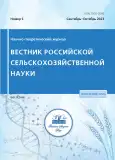Study of wild barley species in Southern Dagestan conditions
- Authors: Batasheva B.A1, Kovaleva O.N2, Abdullaev R.A2, Muslimov M.G3, Radchenko E.E2
-
Affiliations:
- Dagestan OS - branch of VIR, Derbent
- Federal Research Center «All-Russian Institute of Plant Genetic Resources named after N.I.Vavilov»
- Dagestan State University named after M.M. Dzhambulatov
- Issue: No 5 (2023)
- Pages: 10-13
- Section: Articles
- URL: https://journals.rcsi.science/2500-2082/article/view/233549
- DOI: https://doi.org/10.31857/2500-2082/2023/5/10-13
- EDN: https://elibrary.ru/XJJKCH
- ID: 233549
Cite item
Full Text
Abstract
Keywords
About the authors
B. A Batasheva
Dagestan OS - branch of VIR, Derbent
Email: kostek-kum@rambler.ru
O. N Kovaleva
Federal Research Center «All-Russian Institute of Plant Genetic Resources named after N.I.Vavilov»
R. A Abdullaev
Federal Research Center «All-Russian Institute of Plant Genetic Resources named after N.I.Vavilov»
M. G Muslimov
Dagestan State University named after M.M. Dzhambulatov
E. E Radchenko
Federal Research Center «All-Russian Institute of Plant Genetic Resources named after N.I.Vavilov»
References
- Баташева Б.А., Куркиев У.К., Магомедов М.М. Разнообразие ячменя в Дагестане. Дикорастущий вид H.spontaneum C.Koch. // Известия Горского ГАУ.2018.Т.55. №4. С. 203.
- Климашевский Э.Л. Генетический аспект минерального питания растений. М. Агропромиздат, 1991.415 с.
- Кузнецова Т.Е., Серкин Н.В. Селекция ячменя на устойчивость к болезням // Краснодар. "Просвещение-Юг", 2006. 288 с.
- Лоскутов И.Г., Ковалева О.Н., Блинова Е.В. Методические указания по изучению и сохранению мировой коллекции ячменя и овса. С-Пб. ООО "Копи-Р", 2012. 63 с.
- Лукьянова М.В., Трофимовская А.Я., Гудкова Г.Н. и др. Культурная флора СССР. Т. II.Ч. 2. Ячмень. Л. "Агропромиздат", 1990. 424 с.
- Омаров Д.С. Генетические ресурсы ячменя в Дагестане // Ботанические и генетические ресурсы флоры Дагестана. Махачкала, 1981. С. 104-115.
- Яковлева О.В., Капешинский А.М., Ковалева О.Н. Устойчивость культурного и дикого ячменя к действию токсичных ионов алюминия. Тр. по прикл. бот. ген. и сел. 2009. Т.165. С. 51-54
- von Bothmer R., Jacobsen N., Baden C. et al. An ecogeographical study of the genus Hordeum (2nd edition).1995.129 p.
Supplementary files










